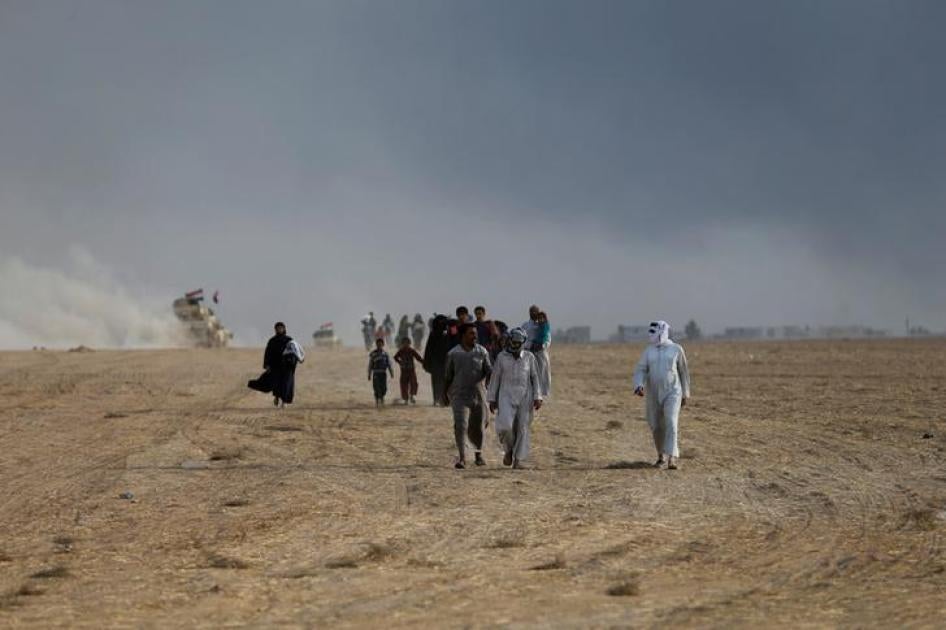(Beirut) – At attack on October 21, 2016, hit the women’s side of al-Khanli mosque in Daquq, 30 kilometers south of Kirkuk, Iraq, killing at least 13 women and children. The strike on the mosque, filled with mourners observing the Muslim holy month of Moharram, occurred without apparent military targets in the vicinity, residents told Human Rights Watch.
A resident and a police officer told Human Rights Watch that they believed the attack on the mosque, which also wounded at least 45 people, was an airstrike because of the sound of aircraft and scale of destruction. Of the troops fighting for the Iraqi city of Mosul, only United States-led coalition forces in Iraq and the Iraqi air force are known to conduct airstrikes in this region. Media outlets have also reported this as an airstrike, likely carried out by the coalition, but a coalition spokesperson denied that they were responsible for the attack and the civilian casualties.
“Even in the heat of battle, armed forces should take all feasible precautions to avoid harming civilians,” said Lama Fakih, deputy Middle East director. “Iraqi forces should investigate whether this was a possible unlawful airstrike that killed civilians and report their findings. If this turns out to be their fault, they should take appropriate measures to compensate the victims.”
The evidence collected by Human Rights Watch is consistent with an airstrike having struck the mosque. However, there is a base for Kurdish Peshmerga forces on the outskirts of Daquq and the city is within shelling range of the extremist group Islamic State, also known as ISIS, forces, according to residents and a nongovernmental security analyst. The nearest ISIS-controlled territory is about 15 kilometres away.
On October 17, Iraqi central government and Kurdistan Regional Government (KRG) authorities, with the support of a US-led international coalition, announced the beginning of the military operation to retake Mosul, Iraq’s second largest city, which ISIS captured in June 2014. The attack that took place on al-Khanli mosque on October 21 took place after ISIS sleeper cells carried out several coordinated attacks in the city of Kirkuk, 150 kilometers southeast of Mosul.
Daquq, part of Iraq’s so-called disputed territories, is under the de facto control of the KRG. Earlier on October 21, at 9 a.m., ISIS carried out a mortar attack on a Peshmerga frontline position about six kilometres from Daquq, according to the police officer. At the time of the mosque attack ISIS fighters were present in Daquq, the security analyst told Human Rights Watch. Residents, however, said that the people killed in the mosque were civilian women and children, and that they did not see any ISIS fighters and were not aware of any other military targets near the strike site.
A resident 500 meters from the site told Human Rights Watch by phone that he did not hear a plane, but heard the missile whizzing in the air, and then a massive explosion when the mosque was struck. He drove to the blast site where he saw that the mosque and four buildings surrounding it had been destroyed and others were damaged.
“We could not find intact bodies of all the victims, with some we just found pieces of human flesh,” he told Human Rights Watch. “I saw too much flesh on the ground. Six bodies were so damaged that the families had to recognize them by their hands.” He said that he did not know of any military targets in the area at the time.
Another resident, who spent many years in the Iraqi military and who was at home 300 meters from the attack, told Human Rights Watch that he heard a plane overhead as his family was in the mosque. The strike killed his sister, and wounded his wife and daughter. He said that for the last four days no mourners had gone to the mosque, but they had decided to congregate in the mosque on the fifth day, when the strike took place. He also did not know what the target of the attack could have been.
The two men told Human Rights Watch that the strike killed at least 13 women and children and wounded at least 45 others. They said they knew all the casualties, who were civilians and all Shias, primarily from the al-Khanli tribe.
Human Rights Watch viewed footage and photos of the aftermath of the strike, which did not show any military structures or forces in the vicinity.
Though media outlets reported this as a US-led coalition airstrike, a coalition spokesman appeared to deny that, telling Human Rights Watch by email that:
At this time, we cannot associate the alleged civilian casualties with any Coalition strikes in the area. The Coalition adheres to targeting processes and procedures aimed to minimize risks to non-combatants. Extraordinary efforts are made by the Coalition to identify and strike appropriate targets in order to avoid non-combatant casualties. We take all reports of non-combatant casualties seriously and assess all incidents as thoroughly as possible.
The coalition’s Operation Inherent Resolve website did not cite any airstrikes in the area at that time.
Given the civilian casualties and the apparent absence of legitimate military targets nearby, the party responsible for the strike should investigate it as a possible violation of the laws of war and publicly report on its findings. If it finds that the attack was an unlawful airstrike, it should commit to appropriate redress measures.
“All forces carrying out ground and air attacks should be extremely vigilant about taking all measures to minimize civilian casualties,” said Fakih. “Any mistakes, as we have seen, could be deadly.”







